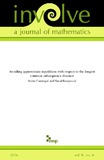| dc.contributor.author | Camungol, Serina | |
| dc.contributor.author | Rampersad, Narad | |
| dc.date.accessioned | 2018-03-15T16:42:07Z | |
| dc.date.available | 2018-03-15T16:42:07Z | |
| dc.date.issued | 2015-09-17 | |
| dc.identifier.citation | Camungol, S., and N. Rampersad. “Avoiding approximate repetitions with respect to the longest common subsequence distance.” Involve 9 (2016): 657-666. DOI: 10.2140/involve.2016.9.657. | en_US |
| dc.identifier.issn | 1944-4176 | |
| dc.identifier.uri | http://hdl.handle.net/10680/1406 | |
| dc.description.abstract | Ochem, Rampersad, and Shallit gave various examples of infinite words avoiding what they called approximate repetitions. An approximate repetition is a factor of the form x x', where x and x' are close to being identical. In their work, they measured the similarity of x and x' using either the Hamming distance or the edit distance. In this paper, we show the existence of words avoiding approximate repetitions, where the measure of similarity between adjacent factors is based on the length of the longest common subsequence. Our principal technique is the so-called “entropy compression” method, which has its origins in Moser and Tardos’s algorithmic version of the Lovász local lemma. | en_US |
| dc.description.sponsorship | Rampersad is supported by an NSERC Discovery Grant. | en_US |
| dc.description.uri | https://msp.org/involve/2016/9-4/p07.xhtml | |
| dc.language.iso | en | en_US |
| dc.publisher | Mathematical Sciences Publishers | en_US |
| dc.rights | info:eu-repo/semantics/openAccess | |
| dc.subject | approximate repetition | en_US |
| dc.subject | longest common subsequence | |
| dc.subject | entropy compression | |
| dc.title | Avoiding approximate repetitions with respect to the longest common subsequence distance | en_US |
| dc.type | Article | en_US |
| dc.identifier.doi | 10.2140/involve.2016.9.657 | |

